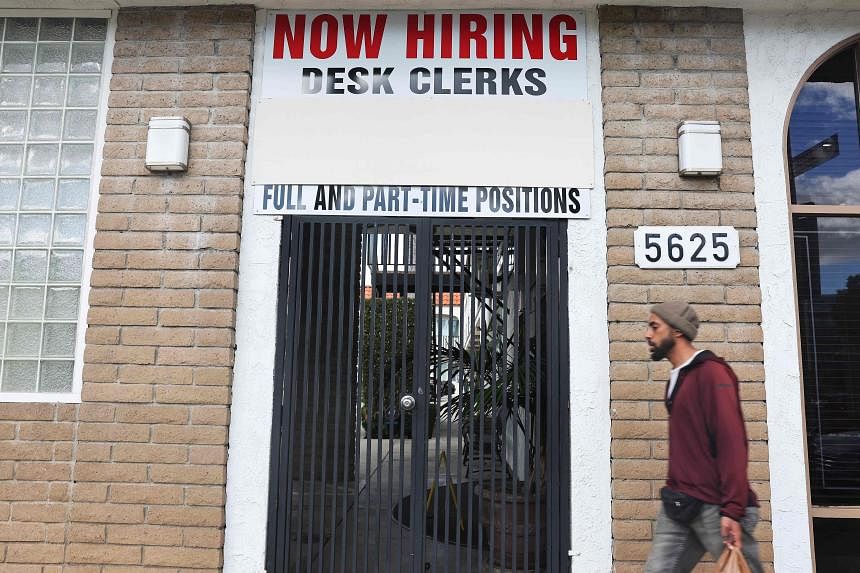WASHINGTON – US job openings fell marginally in January, while the number of workers quitting their jobs dropped to a three-year low, indicating that labour market conditions were gradually easing.
The decline in resignations, which pushed the quits rate to the lowest level in 3½ years, bodes well over time for slower wage inflation and overall price pressures in the economy.
There were 1.45 jobs for every unemployed person in January, up from 1.42 in December, indicating that the labour market remained strong. This was well above the average of 1.2 during the year before the Covid-19 pandemic.
The Job Openings and Labour Turnover Survey (Jolts) report from the Labour Department was published on March 6 as Federal Reserve chairman Jerome Powell presented the US central bank’s semi-annual Monetary Policy Report to lawmakers.
Mr Powell said the Fed expected to start cutting interest rates in 2024, but cautioned that the economic outlook was uncertain, and the ongoing progress towards its 2 per cent inflation objective was “not assured”.
“The Jolts data signal that the jobs market is slowly settling down, consistent with wage, and thus inflation, pressures cooling without a worrisome slowdown in net job creation and overall economic activity,” said Wells Fargo senior economist Sarah House.
“The gradual, rather than marked, softening in the labour market will likely keep the Fed comfortable in waiting a little while longer before beginning to cut rates.”
Job openings, a measure of labour demand, slipped 26,000 to 8.863 million on the last day of January, the Labour Department’s Bureau of Labour Statistics said.
Economists polled by Reuters had forecast 8.9 million job openings in January. Job openings peaked at a record 12.182 million in March 2022. January’s report incorporated annual revisions to the data as well as updates to seasonal adjustment factors, the model used by the government to strip out seasonal fluctuations from the data.
Job openings rose in non-durable goods manufacturing, with 82,000 more positions reported. There were also increases in unfilled jobs in financial activities and professional and business services, as well as in leisure and hospitality industries. But government job openings dropped by 105,000.
Government hiring has significantly contributed to payroll growth in recent months, which had raised worries among some economists that job gains were too concentrated in a handful of sectors. The decline in job openings was concentrated in state and local governments.
In the private sector, private educational services had 41,000 fewer job openings. Vacancies also declined in the retail as well as transport, warehousing and utilities sectors.
Job openings dropped in the south, west and Midwest, but increased in the north-east, with the decrease concentrated among medium-sized and large businesses. Small businesses with one to 49 employees had a large number of vacancies.
The job openings rate was unchanged at 5.3 per cent. Hiring decreased by 100,000 to 5.687 million. There were notable declines in transport, warehousing and utilities, healthcare and social assistance, and state and local education sectors.

The hires rate dipped to 3.6 per cent from 3.7 per cent in December. The labour market is gradually slowing following 525 basis points worth of rate hikes from the Fed since March 2022.
Stocks on Wall Street were trading higher. The dollar fell against a basket of currencies. US Treasury prices rose.
Low layoffs
The number of workers resigning from their jobs, presumably in search of greener pastures, dropped by 54,000 to 3.385 million, the lowest level since January 2021.
A surge in resignations during and after the pandemic was one of the factors behind robust wage growth.
But as more workers stay put, inflation is cooling, with the ADP National Employment report separately showing on March 6 that wages for workers staying in their jobs increased 5.1 per cent in the 12 months to February.
This was the smallest annual gain since August 2021 and followed a 5.3 per cent rise in January.
Fewer workers quit their jobs in the retail sector. There were also significant decreases in resignations in healthcare and social assistance, as well as in professional and business services. But more accommodation and food services workers resigned.
The quits rate, viewed as a measure of labour market confidence, dropped to 2.1 per cent, the lowest since August 2020 and down from 2.2 per cent.
Job cuts were low despite high-profile layoffs at the start of 2024. Layoffs dropped by 35,000 to 1.572 million in January, keeping the layoffs rate at 1 per cent for a third straight month.
The Labour Department is expected to report on March 8 that non-farm payrolls increased by 200,000 jobs in February, according to a Reuters survey. The economy added 353,000 positions in January.
Job growth has cooled from the brisk pace in 2022, but payroll gains are well above the roughly 100,000 jobs needed per month to keep up with growth in the working-age population.
The unemployment rate is forecast to be unchanged at 3.7 per cent, with annual wage growth slowing to 4.4 per cent from 4.5 per cent in January.
“The data is pointing to some rebalancing in supply and demand in the labour market,” said Ms Rubeela Farooqi, chief US economist at High Frequency Economics. REUTERS

